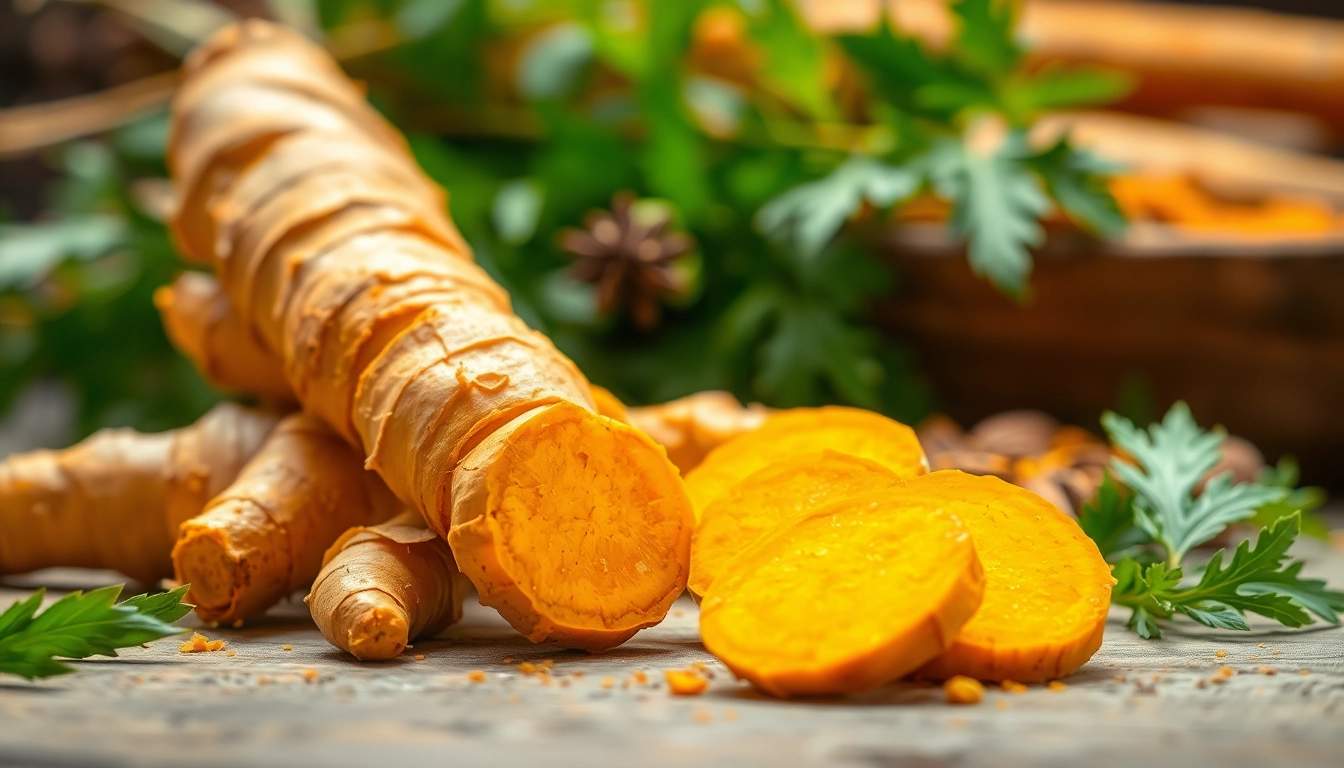Understanding Turmeric Root
What is Turmeric Root?
Turmeric root, scientifically known as Curcuma longa, is a perennial herb belonging to the ginger family. Native to Southeast Asia, it is primarily cultivated for its rhizomes, which are the underground stems typically used in cooking and traditional medicine. Characterized by its vibrant orange-yellow color, turmeric has gained substantial recognition for its culinary and health benefits. Often consumed in its fresh form or dried and ground into a powder, turmeric root is not just another spice in your pantry; it is a rich source of bioactive compounds that contribute to its myriad health benefits. Turmeric Root has been utilized in numerous cultures for centuries, underpinning its significance beyond mere flavoring in foods.
Historical Uses of Turmeric Root
Turmeric root has a long and storied history that dates back over 4,000 years, primarily in South Asia. It has been utilized in Indian and Chinese medicine systems, including Ayurveda and Traditional Chinese Medicine. In these traditions, turmeric is esteemed not only for its flavor but also for its supposed healing properties. Ancient texts reference turmeric for its ability to purify the blood, improve digestion, and treat skin conditions. Moreover, turmeric played a significant role in religious rituals, symbolizing purity, prosperity, and fertility. As trade routes expanded, this spice made its way into various cultures, adapting alongside culinary practices and medicinal uses.
Culinary Applications of Turmeric Root
The culinary applications of turmeric root are as diverse as the regions it has spread to. In Indian cuisine, fresh turmeric is used in a myriad of dishes, from curries to rice preparations, imparting a warm, earthy flavor and a rich yellow hue. Apart from Indian cooking, it has found its way into Middle Eastern and even Western dishes, reflecting its versatility. One can find turmeric in pickles, dressings, and marinades and even baked goods, where it enhances flavor and adds a nutritional boost. Its warm, slightly bitter taste pairs well with ingredients like ginger, garlic, and black pepper, creating a synergy that may enhance both flavor and bioavailability of its active components.
Health Benefits of Turmeric Root
Medicinal Properties Explained
Turmeric root is most widely recognized for its rich content of curcumin, a bioactive component touted for its health-promoting properties. Curcumin has been extensively studied for its anti-inflammatory, antioxidant, and antimicrobial effects. Research suggests that curcumin may help modulate various cellular signaling pathways, thus influencing the body’s response to inflammation and oxidative stress. Furthermore, curcumin’s ability to interact with different molecular targets facilitates its role in combating chronic diseases such as cardiovascular conditions, diabetes, and various forms of cancer.
Turmeric Root for Inflammation Management
Persistent inflammation is often linked to several health problems, including arthritis, heart disease, and Alzheimer’s disease. Turmeric’s anti-inflammatory properties primarily stem from curcumin, which inhibits enzymes and cytokines linked to inflammation. Clinical studies have shown that turmeric supplementation can help reduce joint pain in individuals suffering from osteoarthritis and rheumatoid arthritis. By moderating inflammatory processes in the body, turmeric may also enhance recovery post-exercise and reduce muscle soreness.
Supporting Digestive Health with Turmeric Root
Turmeric root is commonly used to support digestive health. It stimulates the production of bile, which aids in the digestion of fats, and may also help alleviate bloating and gas. Additionally, its antimicrobial properties can promote a balanced gut microbiome, essential for optimal digestion and absorption of nutrients. Turmeric is often used in herbal teas or consumed raw to help settle the stomach and improve overall gut health.
How to Incorporate Turmeric Root into Your Diet
Recipes Featuring Turmeric Root
Incorporating turmeric root into your diet can be both simple and delicious. Here are a few popular recipes:
- Turmeric Ginger Tea: Combine fresh turmeric and ginger with hot water. Let steep, then strain and enjoy. This soothing tea can offer anti-inflammatory benefits.
- Golden Milk: A traditional Ayurvedic drink made with milk (dairy or plant-based), turmeric, black pepper, and a sweetener of choice. It’s a comforting evening beverage.
- Stir-fried Vegetables with Turmeric: Add fresh or powdered turmeric to your favorite stir-fry dishes for an added boost of flavor and nutrition.
Tips for Cooking with Fresh Turmeric Root
Fresh turmeric can be a vibrant addition to your culinary creations. Here are some tips:
- Peeling: Use the edge of a spoon to peel fresh turmeric, as it is easier and reduces waste.
- Storage: Fresh turmeric root can be stored in the refrigerator when wrapped in a paper towel and placed in a plastic bag.
- Pairing: Combine turmeric with black pepper to enhance the absorption of curcumin; this simple pairing can dramatically increase its health benefits.
Dosage and Consumption Guidelines
The appropriate dosage of turmeric root can vary depending on the form and individual needs. Generally, consuming 1-3 grams of fresh turmeric daily is recommended for health benefits. However, if using supplements, it is advisable to follow the manufacturer’s dosage guidelines or consult with a healthcare provider. Remember that curcumin’s bioavailability is enhanced when taken with fats and black pepper, making it important to consider how you consume your turmeric.
Possible Side Effects of Turmeric Root
Understanding Potential Risks
While turmeric root is generally considered safe for most people when consumed in normal dietary amounts, it can present side effects in some cases. High doses of curcumin may lead to gastrointestinal issues such as nausea, diarrhea, or stomach upset. Additionally, curcumin may act as a blood thinner; therefore, caution is advised for individuals on anticoagulant therapy.
Who Should Avoid Turmeric Root?
Certain populations should exercise caution or avoid turmeric root altogether. These include individuals with gallbladder problems, pregnant women (due to its potential to stimulate uterine contractions), and those preparing for surgery. As with any dietary supplement, it is best to consult a healthcare professional before integrating high amounts of turmeric or curcumin into your diet, particularly for individuals with pre-existing health conditions.
Consulting with Healthcare Professionals
Consultation with a healthcare provider can guide the appropriate use of turmeric root, especially for individuals considering it as a supplement for health conditions. A professional can assess potential interactions with medications and offer personalized advice based on individual health status and dietary needs.
Where to Buy Quality Turmeric Root
Finding Organic Turmeric Root
When buying turmeric root, quality matters. Look for organic certification, ensuring that the product is free of pesticides and chemicals. Health food stores, farmers’ markets, and specialty spice shops often carry high-quality turmeric. Online retailers are another viable option, providing access to a broader range of products and sometimes more competitive pricing.
Evaluating Turmeric Root Products in the Market
When evaluating turmeric root products, consider the following factors:
- Form: Choose between fresh, dried, or powdered turmeric based on your cooking preferences.
- Purity: Select products that disclose their ingredient composition clearly, avoiding those with unnecessary additives.
- Customer Reviews: Researching consumer feedback can provide insight into product quality and effectiveness.
Local Markets vs. Online Purchases
Purchasing turmeric root from local markets allows you to inspect the quality and freshness firsthand. However, online shopping offers convenience and a wider selection of turmeric products, including specific varieties and supplements. Weighing both options can ensure you find the best quality that meets your needs.



